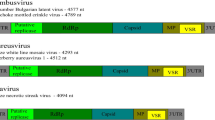Abstract
Cassava mosaic geminiviruses (CMGs) are implicated in cassava mosaic disease (CMD), the main constraint to cassava production in Africa. Here, we report the complete nucleotide sequences of the DNA-A and DNA-B of a newly characterized CMG found infecting cassava in Madagascar, for which we propose the tentative name cassava mosaic Madagascar virus. With the exception of two recombinant regions that resembled a CMG, we determined that the non-recombinant part of the DNA-A component is distantly related to the other CMGs. Whereas the DNA-B component possesses one recombinant region originating from an unidentified virus, the rest of the genome was seen to be closely related to members of the species East African cassava mosaic Zanzibar virus (EACMZV). Phylogenetic analysis based on complete genome sequences demonstrated that DNA-A and DNA-B components are outliers related to the clade of EACMV-like viruses and that DNA-A is related to the monopartite tomato leaf curl begomoviruses described in islands in the south-west Indian Ocean.



Similar content being viewed by others
References
Argüello-Astorga GR, Ruiz-Medrano R (2001) An iteron-related domain is associated to Motif 1 in the replication proteins of geminiviruses: identification of potential interacting amino acid-base pairs by a comparative approach. Arch Virol 146:1465–1485
Boni MF, Posada D, Feldman MW (2007) An exact nonparametric method for inferring mosaic structure in sequence triplets. Genetics 176:1035
Bull SE, Briddon RW, Sserubombwe WS, Ngugi K, Markham PG, Stanley J (2006) Genetic diversity and phylogeography of cassava mosaic viruses in Kenya. J Gen Virol 87:3053–3065
Cours G (1951) Manioc in Madagascar. Mém Inst Scient Madagascar Sér B Biol Vég 3:203–400
Fauquet CM, Briddon RW, Brown JK, Moriones E, Stanley J, Zerbini M, Zhou X (2008) Geminivirus strain demarcation and nomenclature. Arch Virol 153:783–821
Gibbs MJ, Armstrong JS, Gibbs AJ (2000) Sister-scanning: a Monte Carlo procedure for assessing signals in recombinant sequences. Bioinformatics 16:573
Guindon S, Dufayard JF, Lefort V, Anisimova M, Hordijk W, Gascuel O (2010) New algorithms and methods to estimate maximum-likelihood phylogenies: assessing the performance of PhyML 3.0. Syst Biol 59:307–321
Inoue-Nagata AK, Albuquerque LC, Rocha WB, Nagata T (2004) A simple method for cloning the complete begomovirus genome using the bacteriophage φ29 DNA polymerase. J Virol Methods 116:209–211
Jones DR (2003) Plant viruses transmitted by whiteflies. Eur J Plant Pathol 109:195–219
Lefeuvre P, Martin DP, Hoareau M, Naze F, Delatte H, Thierry M, Varsani A, Becker N, Reynaud B, Lett JM (2007) Begomovirus ‘melting pot’ in the south-west Indian Ocean islands: molecular diversity and evolution through recombination. J Gen Virol 88:3458–3468
Legg JP, Fauquet CM (2004) Cassava mosaic geminiviruses in Africa. Plant Mol Biol 56:585–599
Martin D, Rybicki E (2000) RDP: detection of recombination amongst aligned sequences. Bioinformatics 16:562
Martin DP, Posada D, Crandall KA, Williamson C (2005) A modified bootscan algorithm for automated identification of recombinant sequences and recombination breakpoints. AIDS Res Hum Retrovir 21:98–102
Martin DP, Williamson C, Posada D (2005) RDP2: recombination detection and analysis from sequence alignments. Bioinformatics 21:260–262
Ndunguru J, Legg JP, Aveling TAS, Thompson G, Fauquet CM (2005) Molecular biodiversity of cassava begomoviruses in Tanzania: evolution of cassava geminiviruses in Africa and evidence for East Africa being a center of diversity of cassava geminiviruses. Virol J 2:21
Padidam M, Sawyer S, Fauquet CM (1999) Possible emergence of new geminiviruses by frequent recombination. Virology 265:218–225
Patil BL, Fauquet CM (2009) Cassava mosaic geminiviruses: actual knowledge and perspectives. Mol Plant Pathol 10:685–701
Posada D, Crandall KA (2001) Evaluation of methods for detecting recombination from DNA sequences: Computer simulations. Proc Natl Acad Sci USA, In, pp 13757–13762
Ranomenjanahary S, Rabindran R, Robinson DJ (2002) Occurrence of three distinct begomoviruses in cassava in Madagascar. Ann Appl Biol 140:315–318
Smith JM (1992) Analyzing the mosaic structure of genes. J Mol Evol 34:126–129
Thresh JM, Fargette D, Otim-Nape GW (1994) The viruses and virus diseases of cassava in Africa. Afr Crop Sci J 2:459–478
Acknowledgements
This study was funded by the European Union (FEDER), the Région Réunion and CIRAD. MH is a recipient of a PhD fellowship for Regional Cooperation from the Conseil Régional de La Réunion.
Author information
Authors and Affiliations
Corresponding author
Electronic supplementary material
Below is the link to the electronic supplementary material.
705_2012_1399_MOESM1_ESM.eps
Supplementary Fig. 1 Maximum-likelihood (ML) trees showing phylogenetic relationships between the DNA-B component of CMMGV and those of the other representative African and Indian CMGs. Values at nodes indicate the percentage of bootstrap support (1000 replicates; only bootstrap values greater than 70 % are shown). ML trees inferred from alignments of (A) recombinant region c (positions 2367 to 2698) and (B) the non-recombinant region. For begomovirus acronyms and accession numbers, see Supplementary Table 2 (EPS 117 kb)
Rights and permissions
About this article
Cite this article
Harimalala, M., Lefeuvre, P., De Bruyn, A. et al. A novel cassava-infecting begomovirus from Madagascar: cassava mosaic Madagascar virus. Arch Virol 157, 2027–2030 (2012). https://doi.org/10.1007/s00705-012-1399-3
Received:
Accepted:
Published:
Issue Date:
DOI: https://doi.org/10.1007/s00705-012-1399-3




